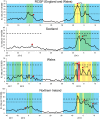Harmonizing influenza primary-care surveillance in the United Kingdom: piloting two methods to assess the timing and intensity of the seasonal epidemic across several general practice-based surveillance schemes
- PMID: 25023603
- PMCID: PMC9206800
- DOI: 10.1017/S0950268814001757
Harmonizing influenza primary-care surveillance in the United Kingdom: piloting two methods to assess the timing and intensity of the seasonal epidemic across several general practice-based surveillance schemes
Abstract
General Practitioner consultation rates for influenza-like illness (ILI) are monitored through several geographically distinct schemes in the UK, providing early warning to government and health services of community circulation and intensity of activity each winter. Following on from the 2009 pandemic, there has been a harmonization initiative to allow comparison across the distinct existing surveillance schemes each season. The moving epidemic method (MEM), proposed by the European Centre for Disease Prevention and Control for standardizing reporting of ILI rates, was piloted in 2011/12 and 2012/13 along with the previously proposed UK method of empirical percentiles. The MEM resulted in thresholds that were lower than traditional thresholds but more appropriate as indicators of the start of influenza virus circulation. The intensity of the influenza season assessed with the MEM was similar to that reported through the percentile approach. The MEM pre-epidemic threshold has now been adopted for reporting by each country of the UK. Further work will continue to assess intensity of activity and apply standardized methods to other influenza-related data sources.
Conflict of interest statement
None.
Figures




References
-
- Public Health England. Real-time Syndromic Surveillance (http://www.hpa.org.uk/Topics/InfectiousDiseases/InfectionsAZ/RealtimeSyn...). Accessed 4 March 2014.
-
- Health Protection Agency. HPA Weekly National Influenza Report (hhttp://www.hpa.org.uk/Topics/InfectiousDiseases/InfectionsAZ/SeasonalInf...). Accessed 4 March 2014.
-
- Department of Health. Seasonal flu plan: Winter 2011/12 (http://www.dh.gov.uk/prod_consum_dh/groups/dh_digitalassets/documents/di...). Accessed 4 March 2014.
-
- National Institute for Health and Clinical Excellence. Oseltamivir, amantadine (review) and zanamivir for the prophylaxis of influenza (http://publications.nice.org.uk/oseltamivir-amantadine-review-and-zanami...). Accessed 4 March 2014.
-
- Fleming DM, et al. The duration and magnitude of influenza epidemics: a study of surveillance data from sentinel general practices in England, Wales and the Netherlands. European Journal of Epidemiology 1999; 15: 467–473. - PubMed
Publication types
MeSH terms
LinkOut - more resources
Full Text Sources
Other Literature Sources
Medical

